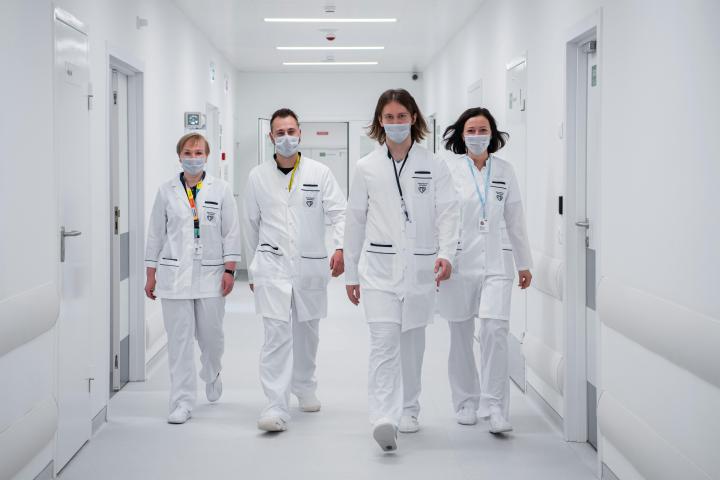
Healthcare Insights: Maternal Death in the U.S. - Worst in the Industrialized World
By John August
Last month, I wrote about the impact on healthcare workers of not being able to live up to the Hippocratic Oath to “Do No Harm.” In that article I focused on the challenges of possible Medicaid cuts and new aggressive immigration enforcement that will increase the likelihood that the most vulnerable among us would be further limited from receiving high-quality healthcare services.
For the past three months, we have been witnessing the cutting of federal jobs, the closure of agencies and departments of the federal government, the slashing of research in the government and across major universities. The impact of these eliminations is being felt today, and will take a long time to replace, repair, and rebuild.
Among the myriad subjects of funding and research cuts is in the area of maternal death.
A week ago, much of the department tasked with monitoring and improving maternal and child health at the Centers for Disease Control and Prevention was placed on leave, while some researchers who study maternal mortality have had their funding rescinded.
Why is this acute reduction in funding so critical?
In a June, 2024 report from the Commonwealth Fund, we learned that:
The US falls behind other countries on maternal health. “For the report, researchers analyzed health data from the Organization for Economic Co-operation and Development for 14 high-income countries. They also used data from CDC's National Vital Statistics Systems, and the agency's Maternal Mortality Review Committees in 36 states.
In 2022, the United States had 22.3 maternal deaths for every 100,000 live births — significantly higher than most other high-income countries. Several countries, including Germany, Australia, and Japan had fewer than five maternal deaths per 100,000 live births.
"In the United States, Black women had the worst maternal mortality rates, eclipsing all other groups at 49.5 deaths per 100,000 live births. In comparison, white women had 19 deaths per 100,000 live births, Hispanic women had 16.9 deaths, and Asian women had 13.2 deaths.”
On April 10, 2025, The New York Times ran a story about new research which illustrates a heretofore lesser known part of the story of maternal death: that it is occurring long after childbirth, often attributable to underlying conditions such as cardiovascular disease. The article notes that:
Overall, the surge in what was observed in all age groups, but a disproportionate increase was seen among women ages 25 to 39. Cardiovascular disease played a leading role.
Pregnancy can affect the cardiovascular system and aggravate underlying conditions like hypertension. At the same time, cardiovascular disease is becoming more prevalent in younger adults, Dr. (Rose) Molina said.
We seem as a society to be getting sicker earlier, (emphasis added) which is why we’re seeing this in that particular age group, Dr. Molina added. She stated that pregnancy can affect the cardiovascular system and aggravate underlying conditions like hypertension. At the same time, cardiovascular disease is becoming more prevalent in younger adults.
The tragic reality of maternal death in the U.S. which includes even worse outcomes based on racial and ethnic disparities is a classic example of a massive contravention of the Hippocratic Oath…not by clinicians, but due to systemic barriers to prevention of the underlying conditions that are the cause of the high rates of maternal death. Over 80% of these deaths are likely preventable.
An article from the American Journal of Public Health (AJPH)) from last year provides deep insight about the efforts underway by researchers and clinicians to improve outcomes for perinatal women. The article describes a combination of research as well as innovative efforts in pre-natal care, delivery, and post-partum observation and care designed to reduce maternal death.
A brief summary of this research, as noted in the AJPH illustrates the in-depth work going on in many settings designed to reduce maternal death, research that now lacks funding:
“Meaningful studies of clinical interventions to reduce maternal morbidity and mortality need to address maternal health or related outcomes and not ancillary outcomes such as the satisfaction of clinicians or their confidence about their knowledge. Studies need a meaningful denominator if an intervention is to be meaningfully tested. They need rigorous designs, and we need to learn something useful and scalable to populations to be considered public health science."
Examples from the article include:
- A geographic information system (GIS) software to estimate driving distance (miles) from mothers’ residences in Conecuh County, Alabama to a hospital for 370 births, which found that most of these deliveries (81%) occurred 22–29 miles from mothers’ homes, but that 18% of deliveries occurred more than 70 miles from mothers’ homes, increasing the chance of adverse delivery outcomes.
- A quality improvement process to increase from 23% to 80% the proportion of pregnant people screened for pre-eclampsia in a family medicine resident prenatal clinic. Results indicated that the proportion of patients prescribed low dose aspirin rose from 79% to 83% of the patients.
- A quality improvement study, showed an increase in COVID-19 vaccination rates over six months from a baseline rate of 30.8% to 60% among pregnant and six-months postpartum people in a marginalized population in a Federally Qualified Community Health Center in western New York.
- An Extension for Community Healthcare Outcomes (ECHO) project provides ongoing professional development and support to health providers in rural and underserved areas of South Dakota.
- A family medicine obstetric track that was developed to train family physicians to provide maternity care services and address a maternity care workforce shortage in Oklahoma.
- A new training track for family medicine residents in Illinois prepared residents to provide evidence-based maternity care in rural and underserved communities, with an emphasis on higher-risk and surgical obstetrics added additional training in evidence-based care for substance use disorders to the usual course of study for family medicine residents providing maternity care.
- “Healthy Moms Clinic” as a clinical practice site for a four-year combined Internal Medicine-Preventive Medicine (IM-PM) residency, with a focus on maternal health serving a high-risk minority and often non-English speaking pregnant population, to facilitate the transition of these high-risk patients to primary care in the IM-PM resident continuity clinic .
- Interprofessional, multinstitutional, high-intensity simulations of obstetrical and neonatal emergencies was created for groups of family medicine residents and nursing students, training together in Texas.
- A Perinatal Resources for Opiate Use Disorder clinic staffed by family medicine-obstetric and Ob/Gyn attending physicians with backgrounds in addiction medicine.
- A clinic that included expanded perinatal and OUD treatment services provided by dedicated certified recovery specialists (CRS), behavioral health, social workers, pharmacists, and program coordinators, in which family medicine and Ob/Gyn residents, fellows in addiction psychiatry, family medicine addiction medicine, and medical students trained.
- Physician trainees (family medicine obstetrics fellows and preventive medicine residents) deployed from four institutions to participate in Maternal Mortality Review Committees (MMRCs) to further their understanding of population maternal health.
The AJPH article notes that “there is no clear pathway to reduce maternal morbidity and mortality in a nation with a medical services marketplace but no organized health care system per se. To reduce maternal morbidity and mortality, we must identify risk factors for individuals as well as use the clinical enterprise to find individuals at risk and use evidence-based approaches to mitigate those risks. Moreover, we need clinical and public health workforces to address those risks, workforces that are adequately trained, supported, and sized. This includes clinicians, appropriately trained and supported, to identify the at-risk individuals in at-risk populations and bring adequately resourced evidence-based interventions to all who might benefit from intervention. These professionals, working in collaboration with an adequately trained and supported public health workforce, would be able to identify and arrest disease outbreaks and undertake public communication about risk factors and risk factor modification.
In the United States, we have many roadblocks to overcome before we can achieve these goals. An organized approach to bringing services to at-risk populations is wanting. Instead, we rely on a market-based approach and can only hope that purveyors of services have adequate financial or ethical incentives to encourage them to address the population at risk. In addition, we lack an evidence base that tells us which disciplines and clinical workforce sizes are effective in addressing the maternal risks the population encounters. Furthermore, we have no organized approach to workforce adequacy. No one is in charge of estimating the workforce we need to address the nation’s population, and no one is in charge of making sure we have enough students and trainees and enough places in health professions schools to ensure we have a right-sized workforce that can address the public health needs.
The United States has a long way to go to address its maternal morbidity and mortality crisis, and the many clinical challenges that face our population. In the United States, we often know what we need to do, but lack the workforce and logistical capacity to address the entire population with the public health science we have.”
The crisis in maternal mortality in the United States has all-too-familiar- root causes:
- Lack of access to care
- Not enough trained professionals to meet the needs of the population in need of care
- Successful research which identifies new and emerging practices which have proven to improve mortality rates, but are not consistently applied
- Cuts in funding for such research
- A systems failure at all levels: without a fully developed public health infrastructure to provide the access necessary for women to high quality and comprehensive pre-natal, maternal, and post-partum care, women in American society will continue to face increasing rates of maternal mortality
Finally, physicians and other healthcare professionals are the ones on the frontlines of care delivery who live with the responsibility to treat patients in this reality. I had the opportunity to interview Amber Higgins, MD.

Dr, Higgins is an attending physician who practices Emergency Medicine and Family Practice Medicine with a specialty on OB/GYN emergency care in Delaware.
I asked Dr. Higgins about her own experience with the rising rates of maternal death, her views on why rates are rising, and how she views this tragedy professionally and personally. Here is what she shared with me:
“I started thinking about maternal death rates in the United States when I was in college when I learned how bad the rates were in the United States compared to the rest of the industrialized world. Then in medical school and all through residency towards becoming an attending (physician), I saw the world of obstetrics in the U.S. to be dominated by a culture of litigiousness, increased interference and intervention into pregnancies; a kind of heavy-handed approach compared to practices in other countries which focus on primary care, pre-natal care, and a culture of prevention and patient education.
Far too many young women in the United States simply don’t have access to primary and pre-natal care. That’s when conditions like anemia, obesity, diabetes, and hypertension are caught. All of these conditions can make pregnancy, delivery, and post-partum experience dangerous. Far too many people lack health care coverage or coverage with too many gaps; they don’t have access to sick leave to take time off from work to see a doctor, and too often there simply are not enough primary care doctors available, and waiting to see one can take a very long time.
In my experience, at least 20% of patients I see have not had pre-natal care. By definition without pre-natal care, a woman enters pregnancy, labor, and delivery with risk factors that we are not even aware of.
Then we are supposed to use a protocol of not seeing a woman after delivery for six weeks. Why is that during pregnancy we see women regularly and with increasing frequency up to the delivery, but then after a few days of post-partum observation, we send women home and don’t see them for another 6 weeks?! Again, the woman is thrown into a situation without primary care, when all research tells us that we should be monitoring all high-risk patients very carefully post-partum.”
Dr. Higgins also shared that, “In many states that have outlawed abortion, many women are denied necessary care in the early stages of pregnancy when they have miscarriages or other anomalies in pregnancy. The impact on women’s health is profound. When “death is imminent” is the criterion for providing care, an abortion could occur at 14 weeks which is a complicated medical procedure. These procedures which should be done much earlier can have lasting impact on the woman’s health. They should be avoided with earlier detection and action, when procedures are safer.”
I asked Dr. Higgins about how the culture of lack of maternal health and high death rates impact her professionally and personally. She shared two major feelings and concerns:
“First, as I said earlier, in the U.S. we have a heavy hand with pregnant women, with the focus on intervention which in my view is due to a culture of litigiousness in the field. Any suspicion of a problem, grounded or not can shake the confidence of the doctor. I see thousands of patients every year, and even a complaint, let alone an accusation of wrongdoing can shake one’s confidence to the core.
And due to the severe shortage of primary care and pre-natal care providers, I am afraid to seek work-life balance to raise my own family and care for my own loved ones. I would feel guilty cutting back my hours or workload knowing there may not be anyone to replace me. We physicians keep all these things to ourselves and are not good at seeking care for ourselves when we need it. These burdens pile up, and we face burnout as a result.”
I also spoke with Dr. Howard Goldstein from the same system. He is an attending physician who specializes in urogynecology and surgery. On the same issues I discussed with Dr. Higgins, he said: “Care in the U.S. is not longitudinal, it is interventional, and as a result, so many people just fall through the cracks. Though health systems have massive resources, we wind up in situations where Obstetricians never meet patients until the time of delivery. In other words, far too often patients and physicians don’t know anything about one another until they meet for a delivery or a procedure. Of course, doctors today have access to patient information, but that simply describes the patient’s history in the moment, and does not reflect the history of care or lack of care.”
My sense is that as we watch cuts in funding for health sciences research, people know this is wrong.
At the same time, we must learn that our health system is already broken and that cuts in funding are only the latest in systems failure. For far too many the system collapsed a long time ago.
Finally, I have been asking the following question of late as we fear that Medicaid will be cut for its nearly 80 million recipients, who are predominantly children, women, and the rapidly increasing number of Americans who cannot afford health insurance or out-of-pocket costs of office visits, medicine, dental care, or other health needs. The question I ask is this:
How does the richest country in the world have 80 million people who are eligible for what was supposed to be a “safety net program” when it was established in 1965?
Lack of affordability and access to healthcare has become the singular indicator of whole system failure. Nearly $1 trillion is spent each year on care for people who cannot afford healthcare.
We need research on maternal death restored, of course.
We need to look deeply at the way we allocate resources more broadly.
We must have clarity that the healthcare professionals who provide the care we need are also falling through the cracks.
John August is the Scheinman Institute’s Director of Healthcare and Partner Programs. His expertise in healthcare and labor relations spans 40 years. John previously served as the Executive Director of the Coalition of Kaiser Permanente Unions from April 2006 until July 2013. With revenues of 88 billion dollars and over 300,000 employees, Kaiser is one of the largest healthcare plans in the US. While serving as Executive Director of the Coalition, John was the co-chair of the Labor-Management Partnership at Kaiser Permanente, the largest, most complex, and most successful labor-management partnership in U.S. history. He also led the Coalition as chief negotiator in three successful rounds of National Bargaining in 2008, 2010, and 2012 on behalf of 100,000 members of the Coalition.



